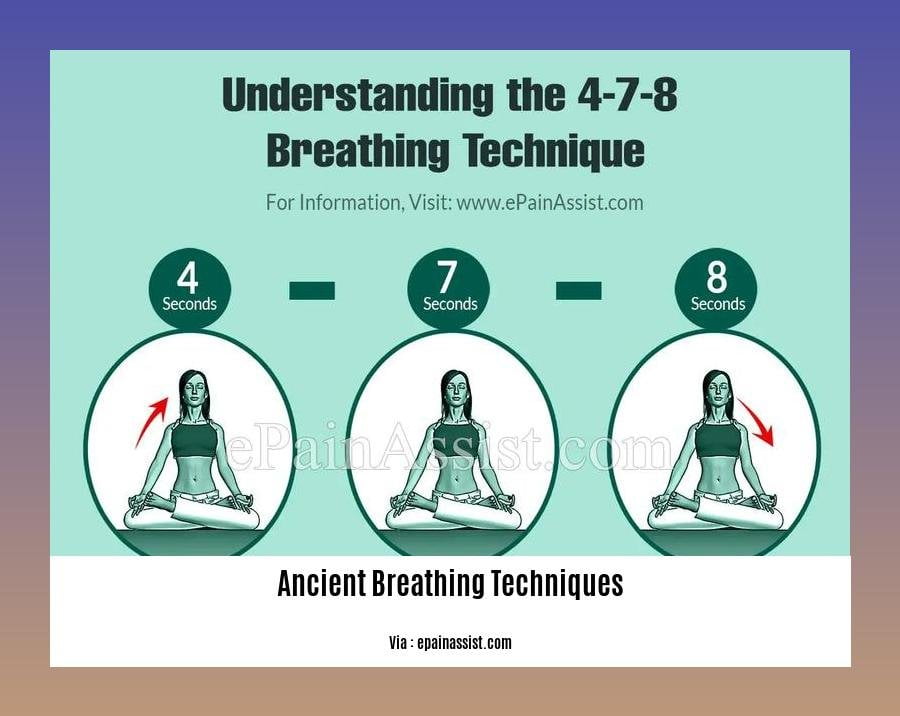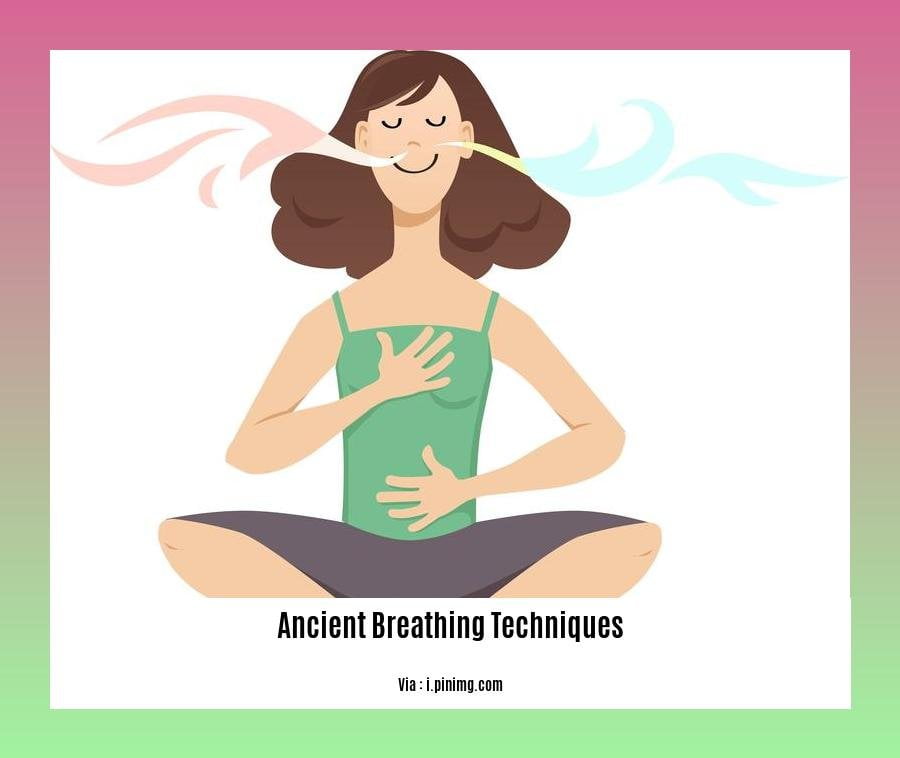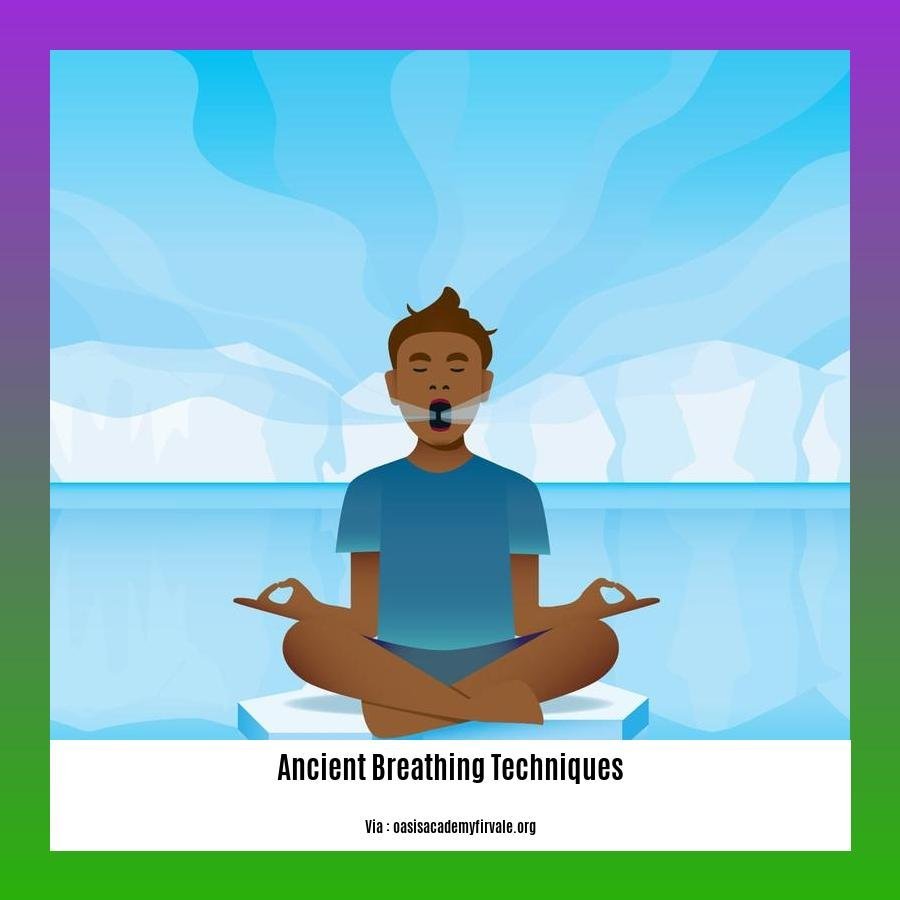Embark on an enlightening journey to enhanced well-being as we unveil the power of ancient breathing techniques in “[Unveiling the Power of Ancient Breathing Techniques: A Journey to Enhanced Well-being].” Rooted in traditions of yoga and meditation, discover how these age-old practices can unlock a world of revitalization, tranquility, and heightened vitality.
Key Takeaways:
Ancient breathing techniques are methods of controlling and improving breath for various purposes like relaxation, detoxification, and energy.
Examples of ancient breathing techniques include:
- Ujjayi Breathing: Calms the mind and body by creating a soft sound in the throat.
- Bhastrika (Breath of Fire): Boosts metabolism and digestion through rapid and forceful inhalations and exhalations.
- Relaxing Breath: Reduces stress and anxiety by exhaling longer than inhaling.
Cleansing Breath: Clears the respiratory system by inhaling deeply through the nose and exhaling forcefully through the mouth.
Ancient breathing techniques aim to enhance physical, mental, and spiritual well-being.
These techniques have the potential to improve overall health and well-being naturally.
Ancient Breathing Techniques: A Journey to Enhanced Well-being

In a world that values high-paced living, we often find ourselves caught in a cycle of stress, anxiety, and physical discomfort. Ancient breathing techniques offer a time-honored solution to combat these modern-day ills. Rooted in holistic practices, these techniques harness the transformative power of the breath to promote physical, mental, and spiritual well-being.
What Are Ancient Breathing Techniques?
Ancient breathing techniques are a collection of practices that regulate and optimize the breath. Employing specific patterns, rhythms, and sequences, these techniques have been used for centuries to improve overall health and well-being. Some popular ancient breathing techniques include:
Ujjayi Breathing: This technique involves a gentle constriction of the throat, creating a soft, audible sound during inhalation and exhalation. Ujjayi breathing calms the mind and body, promotes focus, and increases energy levels.
Bhastrika (Breath of Fire): A more vigorous technique, Bhastrika involves rapid and forceful inhalations and exhalations through the nose. This technique stimulates the metabolism, aids digestion, and energizes the body.
Relaxing Breath: A simple yet effective technique, Relaxing Breath involves exhaling longer than inhaling. It helps reduce stress and anxiety, promotes relaxation, and improves sleep quality.
Cleansing Breath: This technique involves deep inhalations through the nose and forceful exhalations through the mouth. Cleansing Breath clears the respiratory system, enhances circulation, and invigorates the entire body.
Unveiling the Benefits of Ancient Breathing Techniques
Ancient breathing techniques offer a myriad of benefits for both the body and mind. By consciously controlling the breath, we can positively influence our physical, mental, and spiritual well-being.
- Physical Benefits:
- Reduces stress and anxiety: Ancient breathing techniques activate the parasympathetic nervous system, which promotes relaxation and reduces the body’s stress response.
- Improves respiratory function: Deep and controlled breathing techniques strengthen the respiratory muscles, increase lung capacity, and enhance oxygen intake.
- Boosts energy levels: Intentional breathing practices provide a surge of energy, improving physical performance and reducing fatigue.
Enhances sleep quality: Ancient breathing techniques help calm the mind, reduce racing thoughts, and create a conducive environment for restful sleep.
Mental Benefits:
- Increases focus and concentration: Controlled breathing techniques enhance cognitive function, improve attention span, and sharpen concentration.
- Improves mood and reduces anxiety: Ancient breathing techniques stimulate the release of endorphins, which have mood-boosting and stress-reducing effects.
Promotes emotional balance: Regular practice of ancient breathing techniques helps manage emotions, fostering greater emotional stability and resilience.
Spiritual Benefits:
- Deepens spiritual connection: Ancient breathing techniques are often incorporated into meditative and spiritual practices, facilitating a deeper connection with the self and the universe.
- Enhances self-awareness: Conscious breathing practices cultivate self-awareness, promoting introspection and a greater understanding of one’s inner self.
- Fosters a sense of peace and well-being: Regular practice of ancient breathing techniques cultivates a profound sense of inner peace, tranquility, and overall well-being.
Incorporating Ancient Breathing Techniques into Your Lifestyle
Embracing ancient breathing techniques into your daily routine is a simple yet transformative way to enhance your well-being. Here’s how you can get started:
Find a Quiet Space: Choose a comfortable and quiet environment where you won’t be disturbed.
Start with a Short Session: Begin with a 5-10 minute session and gradually increase the duration as you become more comfortable.
Focus on Your Breath: Close your eyes and bring your attention to your breath. Notice the rise and fall of your chest and abdomen.
Practice Different Techniques: Experiment with different ancient breathing techniques to find the ones that resonate with you.
Be Consistent: Regular practice is key to experiencing the full benefits of ancient breathing techniques. Aim to practice for at least a few minutes each day.
Remember, ancient breathing techniques are a powerful tool for self-care and well-being. By incorporating them into your daily routine, you can harness the transformative power of your breath to unlock a world of health and vitality.
Searching for a collagen supplement that not only supports your skin’s health but also packs a punch of antioxidants? Dive into ancient and brave collagen and discover the secret to glowing skin and youthful vitality.
Enhance your wellness routine with the ancient and brave mct oil, a powerhouse of energy-boosting fatty acids that will keep you going strong all day long.
Step-by-Step Instructions for Performing Ancient Breathing Techniques

Unlock the transformative power of ancient breathing techniques and embark on a journey to enhanced well-being.
Have you ever felt overwhelmed by life’s demands, struggling with stress, anxiety, or sleep deprivation?
What if there was a simple yet profound way to alleviate these ailments and cultivate a sense of inner peace and harmony?
Unveiling the secrets of ancient breathing practices can be your gateway to a healthier, more fulfilling life. Experience the benefits of these time-honored techniques, ranging from reduced stress to improved sleep and enhanced cognitive function.
Key Takeaways:
- Ancient breathing techniques are not just exercises; they are a journey of self-discovery and holistic well-being.
- Incorporating these techniques into your daily routine can transform your physical, mental, and spiritual health.
- With regular practice, you’ll unlock the secrets of ancient wisdom and discover a path to inner peace and vitality.
Let’s embark on this transformative journey together. Explore step-by-step instructions for performing ancient breathing techniques and witness the remarkable impact they can have on your life.
Step 1: Diaphragmatic (Belly) Breathing
- Find a comfortable position, sitting upright with your spine straight or lying down on your back.
- Place one hand on your chest and the other on your abdomen, just below your rib cage.
- Take a deep breath in through your nose, allowing your belly to expand and your diaphragm to contract. Your chest should remain relatively still.
- Exhale slowly through your mouth, feeling your abdomen contract and your diaphragm relax.
- Repeat for 5-10 minutes, focusing on the sensation of your breath moving in and out of your body.
Step 2: Box Breathing
- Find a quiet place where you won’t be disturbed.
- Sit or lie down in a comfortable position with your spine straight.
- Close your eyes and take a deep breath in through your nose for four counts.
- Hold your breath for four counts.
- Exhale slowly through your mouth for four counts.
- Hold your breath out for four counts.
- Repeat the cycle for 5-10 minutes.
Step 3: Equal Breathing
- Find a comfortable position, either sitting or lying down.
- Close your eyes and focus on your breath.
- Inhale and exhale slowly and evenly through your nose for a count of four.
- Continue breathing in and out for four counts each until you feel relaxed.
- Practice for 5-10 minutes.
Embrace the Power of Breathwork
These ancient breathing techniques are accessible to anyone, regardless of age or fitness level. With regular practice, you’ll unlock the transformative power of breathwork, promoting physical, mental, and spiritual well-being. Experience reduced stress, improved sleep, enhanced focus, and a renewed sense of vitality.
Citations:
[1] “Diaphragmatic Breathing Exercises for Relaxation”
https://www.healthline.com/health/diaphragmatic-breathing
[2] “Box Breathing Technique for Stress Relief”
Tips for practicing ancient breathing techniques effectively:
In our modern world, where stress and technology dominate our lives, it’s easy to forget the power of our breath. Ancient breathing techniques have been practiced for centuries to promote physical, mental, and spiritual well-being. Here’s how you can harness their power:
1. Start Slowly:
- Don’t try to do too much too soon. Start with a few minutes of practice each day and gradually increase the duration as you become more comfortable.
2. Find a Quiet Place:
- Choose a peaceful environment where you won’t be disturbed. This will help you focus on your breath and relax your body.
3. Focus on Your Breath:
- Pay attention to the sensation of your breath as it enters and leaves your body. Feel the rise and fall of your chest and abdomen.
4. Experiment with Different Techniques:
- There are many different ancient breathing techniques to choose from. Try a few and see which ones you find most beneficial.
5. Be Consistent:
- The key to reaping the benefits of ancient breathing techniques is consistency. Make it a part of your daily routine and you’ll start to see results in no time.
Key Takeaways:
- Ancient breathing techniques can reduce stress, improve sleep, enhance cognitive function, support physical health, and regulate emotions.
- Start slowly, find a quiet place, focus on your breath, experiment with different techniques, and be consistent in your practice.
- Diaphragmatic breathing, equal breathing, and box breathing are some effective techniques to try.
Sources:
The Power of Breathing: A Simple Technique to Improve Your Health and Well-being
5 Ancient Breathing Techniques for Better Health and Well-being
Common mistakes to avoid when practicing ancient breathing techniques
In our quest for holistic well-being, we may embark on the journey of ancient breathing techniques, seeking to harness their transformative power. However, certain pitfalls can hinder our progress and diminish the benefits we seek.
To ensure a fruitful and enriching experience with ancient breathing techniques, let’s shed light on some common blunders to steer clear of:
Misinterpreting the Purpose:
Mistake: Viewing breathing techniques merely as physical exercises, neglecting their holistic impact on mind and spirit.
Remedy: Embrace the comprehensive nature of these practices, recognizing their ability to harmonize body, mind, and soul.
Adopting a Rigid Approach:
Mistake: Inflexibly adhering to specific techniques without considering individual needs and preferences.
Remedy: Allow yourself the freedom to explore diverse techniques, tailoring your practice to suit your unique requirements.
Pushing Your Limits Too Soon:
Mistake: Attempting advanced techniques prematurely, disregarding the importance of gradual progression.
Remedy: Start with fundamental techniques, gradually building your skill and comfort level before moving on to more intricate practices.
Ignoring the Significance of Breath Awareness:
Mistake: Focusing solely on controlling the breath, overlooking the value of mindful observation.
Remedy: Cultivate a deep connection with your breath, paying attention to its natural flow and subtle nuances.
Neglecting Proper Posture:
Mistake: Practicing breathing techniques in an improper or uncomfortable posture, hindering the flow of energy.
Remedy: Prioritize maintaining a stable and relaxed posture, allowing for optimal breath movement.
Overexerting Yourself:
Mistake: Engaging in excessively long or intense sessions, leading to strain and potential discomfort.
Remedy: Begin with shorter sessions and gradually increase the duration as you become more accustomed to the practice.
Practicing in an Unconducive Environment:
Mistake: Choosing a noisy or distracting environment, undermining the tranquility necessary for effective practice.
- Remedy: Seek out a calm and serene space, free from external disturbances, to facilitate a deeper connection with your breath.
Key Takeaways:
Ancient breathing techniques offer a holistic approach to well-being, harmonizing body, mind, and spirit.
Tailor your practice to suit your individual needs and preferences, avoiding a rigid adherence to specific techniques.
Start with fundamental techniques, progressing gradually to more advanced practices as you become more comfortable.
Cultivate a deep connection with your breath, paying attention to its natural flow and subtle nuances.
Prioritize maintaining a stable and relaxed posture, allowing for optimal breath movement.
Begin with shorter sessions and gradually increase the duration as you become more accustomed to the practice.
Choose a calm and serene environment, free from external disturbances, to facilitate a deeper connection with your breath.
Citations:
Ancient Breathing Techniques for Deeper Mind, Body, and Spirit Connection
3 Ancient Breathing Techniques for a Deeper Mind, Body, Spirit Connection
FAQ
Q1: What are the origins of ancient breathing techniques?
A1: Ancient breathing techniques have been practiced for centuries, originating from various cultures worldwide, such as India, China, and Egypt. These techniques were developed as a way to enhance physical, mental, and spiritual well-being.
Q2: How do ancient breathing techniques work?
A2: Ancient breathing techniques work by manipulating the breath to achieve specific effects on the body and mind. By controlling the rate, depth, and pattern of breathing, these techniques can stimulate the nervous system, promote relaxation, reduce stress, and improve cognitive function.
Q3: What are some common ancient breathing techniques?
A3: Some common ancient breathing techniques include Ujjayi breathing (ocean breath), Bhastrika (breath of fire), relaxing breath, and cleansing breath. These techniques vary in their specific patterns and effects, but they all involve controlling the breath in different ways to achieve specific outcomes.
Q4: What are the benefits of practicing ancient breathing techniques?
A4: Practicing ancient breathing techniques can provide numerous benefits, including reduced stress and anxiety, improved sleep quality, enhanced cognitive function, support for physical health, and improved emotional regulation. By incorporating these techniques into your daily routine, you can enhance your overall well-being and promote a healthier lifestyle.
Q5: How can I learn ancient breathing techniques?
A5: Learning ancient breathing techniques is accessible to everyone. You can find resources online, in books, or by attending workshops or classes led by experienced instructors. Start with simple techniques and gradually work your way up to more advanced practices as you become more comfortable with the process.












